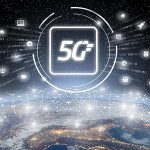The activity follows approval for satellite-driven 5G non-terrestrial networks from the 3GPP global telecommunications standards body.
 Ericsson and Qualcomm have teamed up with Thales to test satellite-delivered, space-based 5G services to global customers and to validate that 5G non-terrestrial networks (NTN) can be supported in a smartphone form factor allowing the device to effectively become a satellite-phone.
Ericsson and Qualcomm have teamed up with Thales to test satellite-delivered, space-based 5G services to global customers and to validate that 5G non-terrestrial networks (NTN) can be supported in a smartphone form factor allowing the device to effectively become a satellite-phone.
The result can effectively mean that a future 5G smartphone can use 5G connectivity anywhere on Earth and provide complete global coverage for wideband data services, including places normally only covered by legacy satellite phone systems with limited data connectivity capabilities.
The benefits of 5G connectivity via low Earth Orbit (LEO) satellites are expected to include coverage in extreme geographies or remote areas across seas, oceans and other locations where terrestrial coverage is absent.
Such widespread connectivity will boost 5G smartphone subscriber roaming service capabilities, as well as enabling global connectivity for transportation, energy and health sector 5G use cases.
The space-based network can also be used as back-up support to terrestrial networks in the event of major network outages or disasters.
The expected security capabilities of 5G NTNs mean that national government communications may be a main use case, to enhance safe and secure national security and public safety government networks.
Speaking about the partnership, Erik Ekudden, Senior Vice President and Chief Technology Officer of Ericsson, said: This testing and validation cooperation between Ericsson, Thales and Qualcomm Technologies will be a major milestone in the history of communications as the ultimate result could effectively mean that no matter where you are on Earth in the middle of an ocean or the remotest forest high-end, secure and cost-effective connectivity will be available through collaborative 5G satellite and terrestrial connectivity.
John Smee, Senior Vice President of Engineering, Qualcomm Technologies, Inc., added: For 5G to fulfil on the promise of ubiquitous connectivity, it is imperative that it can also deliver network coverage in areas where terrestrial cellular networks do not exist, whether that be over oceans or in remote areas. Our planned research with Ericsson and Thales will kick off an important step in making this vital technology a reality. We are looking forward to what this collaboration can accomplish.
Philippe Keryer, Executive Vice-President of Strategy, Research and Technology, Thales, stated: The deployment of 5G networks marks a step-change for the telecoms industry. It is a game-changer, not only in terms of business opportunities but also in the skills required to connect and protect billions of people and things. Thales is deeply involved in it through the different activities of the group. The research collaboration with Ericsson and Qualcomm Technologies will demonstrate the belief of our companies that 5G non-terrestrial Networks will contribute to this revolution and will take network resiliency and security to the next level.
The testing and validation by Ericsson, Thales and Qualcomm Technologies following the March 2022 go-ahead by 3GPP the global telecommunications standards body is intended to support non-terrestrial networks for the first time.
The goal of the testing will be to validate various technology components needed to enable 5G non-terrestrial networks, including a 5G smartphone, satellite payload and 5G network pieces on the ground.
Ericsson plans to verify a 5G virtual RAN (vRAN) stack, modified to handle radio signals propagating (what happens to 5G radio waves travelling through the vacuum of space and the Earths atmosphere) via the fast-moving LEO satellites.
Thales plans to verify a 5G radio satellite payload suitable for deployment on LEO satellites, while Qualcomm Technologies plans to provide test phones verifying that 5G NTN can be accessed by future 5G smartphones.
Experts will use ground-based equipment to emulate the 5G radio propagation and time delays between an equipped satellite in orbit and connecting a 5G smartphone with the 5G radio access network at different places on the Earths surface.
Ekudden commented: While it is too early to say when any resulting 5G equipped prototype satellite could be launched into orbit for real operational use, the highly technical ground-based testing and validation work planned between Ericsson, Thales and Qualcomm Technologies is key to making it happen.
As a 3GPP-backed technology, 5G NTNs will be able to capitalise on a large ecosystem of standardised products and components. The new specification also enables the inclusion of NTN technologies in 5G devices, providing opportunities for technology vendors to easily and quickly scale 5G NTN compatibility across devices.













































































